Spatial Layout Analysis and Evaluation of Electric Vehicle Charging Infrastructure in Chongqing
Abstract
1. Introduction
2. Research Methods and Data Sources
2.1. Study Area
2.2. Research Approach
2.3. Methodology and Model
2.3.1. EV Charging Infrastructure Supply—Accessibility
- (1)
- Charging station service capability
- (2)
- The total cost of charging at the charging station
- (3)
- The accessibility value of EV charging infrastructure at sample sites
- (4)
- Accessibility value of electric vehicle charging infrastructure in the central urban area of Chongqing
2.3.2. EV Charging Infrastructure Demand—Kernel Density Value
2.3.3. Balance of Supply and Demand of EV Charging Infrastructure—Balance Index
2.3.4. Spatial Layout Optimization of EV Charging Infrastructure—Optimization Value
2.3.5. EV Charging Infrastructure Location and Capacity Setting Options—Questionnaire Measurement and Hierarchical Analysis
2.4. Data Source and Processing
3. Analysis of the Results
3.1. Analysis of Electric Vehicle Charging Post Supply
3.2. Supply–Demand Matching Analysis of Electric Vehicle Charging Posts
3.3. EV Charging Posts Spatial Layout Optimization Goals and Ideas
3.4. Spatial Layout Optimization Scheme of Electric Vehicle Charging Stack
3.4.1. Electric Vehicle Charging Infrastructure Site Selection Index System and Weight
- (1)
- Building the Hierarchical Structure Model
- (2)
- Reliability and Validity Analysis of the Measurement Questionnaire
- (3)
- Construction of the Judgment Matrix
- (4)
- Index Weight and Consistency Test
3.4.2. Electric Vehicle Charging Infrastructure Layout Optimization Scheme
4. Discussion
5. Conclusions
- (1)
- The spatial differentiation of charging infrastructure configuration and demand in the central urban area of Chongqing is obvious and shows strong centrality. On a large scale, the core density value, availability value, and optimization value all gradually decrease from Yuzhong District to the surrounding area. On a small scale, some local centers also produce similar phenomena in local areas. The main reason for this phenomenon is the difference in regional economic development levels and population differences.
- (2)
- It is a common phenomenon that the demand for charging infrastructure in the central urban area of Chongqing exceeds the supply. The speed and quality of the construction of charging infrastructure cannot meet the growing demand for electric vehicles. Approximately 80% of the areas are in short supply, and building new charging infrastructure is urgently needed.
- (3)
- Local centers should be considered first when optimizing the construction of charging infrastructure. When selecting a specific construction site, a field survey should be conducted, taking into account various factors such as economy and traffic. At the same time, the charging infrastructure should ensure the operation process to reduce the impact of nonelectric vehicle crowding and equipment failure without maintenance on the operation efficiency.
Author Contributions
Funding
Institutional Review Board Statement
Informed Consent Statement
Data Availability Statement
Acknowledgments
Conflicts of Interest
References
- Deb, S.; Gao, X.Z.; Tammi, K. A novel chicken swarm and teaching learning based algorithm for electric vehicle charging station placement problem. Energy 2021, 220, 119645. [Google Scholar] [CrossRef]
- Pan, A.; Zhao, T.; Yu, H. Deploying public charging stations for electric taxis: A charging demand simulation embedded approach. IEEE Access 2019, 7, 17412–17424. [Google Scholar] [CrossRef]
- Liu, Z.; Wen, F.; Ledwich, G. Optimal planning of electric-vehicle charging stations in distribution systems. IEEE Trans. Power Deliv. 2012, 28, 102–110. [Google Scholar] [CrossRef]
- Wang, C.; Xie, D.; Gu, C. Planning of Regional Urban Bus Charging Facility: A Case Study of Fengxian, Shanghai. IEEE Trans. Intell. Transp. Syst. 2021, 23, 13592–13603. [Google Scholar] [CrossRef]
- Zhu, Z.; Gao, Z.; Zheng, J. Charging station planning for plug-in electric vehicles. J. Syst. Sci. Syst. Eng. 2018, 27, 24–45. [Google Scholar] [CrossRef]
- Meng, X.; Zhang, W.; Bao, Y. Sequential construction planning of electric taxi charging stations considering the development of charging demand. J. Clean. Prod. 2020, 259, 120794. [Google Scholar] [CrossRef]
- Huang, Y.; Kockelman, K.M. Electric vehicle charging station locations: Elastic demand, station congestion, and network equilibrium. Transp. Res. Part D Transp. Environ. 2020, 78, 102179. [Google Scholar] [CrossRef]
- Pal, A.; Bhattacharya, A.; Chakraborty, A.K. Allocation of electric vehicle charging station considering uncertainties. Sustain. Energy Grids Netw. 2021, 25, 100422. [Google Scholar] [CrossRef]
- Zilong, C.; Pin, W.; Jian, S.; Bo, Y. Electric Vehicle public emergency charging station location planning model. Electr. Power Syst. Prot. Control 2020, 48, 62–68. [Google Scholar]
- Atmaja, T.D.; Mirdanies, M. Electric vehicle mobile charging station dispatch algorithm. Energy Procedia 2015, 68, 326–335. [Google Scholar] [CrossRef]
- Tadayon-Roody, P.; Ramezani, M.; Falaghi, H. Multi-objective locating of electric vehicle charging stations considering travel comfort in urban transportation system. IET Gener. Transm. Distrib. 2021, 15, 960–971. [Google Scholar] [CrossRef]
- Jianshu, G.; Mingqiang, W.; Zhaokang, S.; Jingchang, Z.; Shujian, X. Research on Location of Airport Charging Pile based on Genetic Algorithm. Comput. Eng. Appl. 2018, 54, 210–216. (In Chinese) [Google Scholar]
- Taylor, J.; Maitra, A.; Alexander, M. Evaluation of the Impact of Plug-in Electric Vehicle Loading on Distribution System Operations. In Proceedings of the 2009 IEEE Power & Energy Society General Meeting, Calgary, AB, Canada, 26–30 July 2009; pp. 1–6. [Google Scholar]
- Kuby, M. Heuristic Algorithms for Siting Alternative-Five-Fuel Stations Using the Flow-Refueling Location Model. Eur. J. Oper. Res. 2010, 204, 51–61. [Google Scholar]
- Lee, T.K.; Bareket, Z.; Gordon, T. Stochastic modeling for studies of real-world PHEV usage: Driving schedule and daily temporal distributions. IEEE Trans. Veh. Technol. 2012, 4, 1493–1502. [Google Scholar] [CrossRef]
- Yao, L.; Damiran, Z.; Lim, W.H. Optimal charging and discharging scheduling for electric vehicles in a parking station with photovoltaic system and energy storage system. Energies 2017, 10, 550. [Google Scholar] [CrossRef]
- Zu, S.; Sun, L. Research on location planning of urban charging stations and battery-swapping stations for electric vehicles. Energy Rep. 2022, 8, 508–522. [Google Scholar] [CrossRef]
- Xiong, Y.; An, B.; Kraus, S. Electric vehicle charging strategy study and the application on charging station placement. Auton. Agents Multi.-Agent Syst. 2021, 35, 3. [Google Scholar] [CrossRef]
- Yi, T.; Cheng, X.; Zheng, H. Research on location and capacity optimization method for electric vehicle charging stations considering user’s comprehensive satisfaction. Energies 2019, 12, 1915. [Google Scholar] [CrossRef]
- Zhang, P.; Chen, J.; Tu, L. Layout Evaluation of New Energy Vehicle Charging Stations: A Perspective Using the Complex Network Robustness Theory. World Electr. Veh. J. 2022, 13, 127. [Google Scholar] [CrossRef]
- Wu, F.; Sioshansi, R. A stochastic flow-capturing model to optimize the location of fast-charging stations with uncertain electric vehicle flows. Transp. Res. Part D Transp. Environ. 2017, 53, 354–376. [Google Scholar] [CrossRef]
- Gong, D.; Tang, M.; Buchmeister, B. Solving location problem for electric vehicle charging stations—A sharing charging model. IEEE Access 2019, 7, 138391–138402. [Google Scholar] [CrossRef]
- Qiao, Y.; Huang, K.; Jeub, J. Deploying electric vehicle charging stations considering time cost and existing infrastructure. Energies 2018, 11, 2436. [Google Scholar] [CrossRef]
- Răboacă, M.S.; Băncescu, I.; Preda, V. An optimization model for the temporary locations of mobile charging stations. Mathematics 2020, 8, 453. [Google Scholar] [CrossRef]
- Sijie, L.; Fumin, Z.; Feng, G.; Luchao, L. Taxi charging station location Method based on Trajectory Data. Comput. Eng. Appl. 2022, 58, 273–282. (In Chinese) [Google Scholar]
- Pagany, R.; Marquardt, A.; Zink, R. Electric charging demand location model—A user-and destination-based locating approach for electric vehicle charging stations. Sustainability 2019, 11, 2301. [Google Scholar] [CrossRef]
- Csiszár, C.; Csonka, B.; Földes, D.; Wirth, E.; Lovas, T. Urban public charging station locating method for electric vehicles based on land use approach. Transp. Geogr. 2019, 74, 173–180. [Google Scholar] [CrossRef]
- Chen, Z.; Zhang, Z.; Zhao, J.; Wu, B.; Huang, X. An analysis of the charging characteristics of electric vehicles based on measured data and its application. IEEE Access 2018, 6, 24475–24487. [Google Scholar] [CrossRef]
- Sh Chen, Y.; Lin, B. Are consumers in China’s major cities happy with charging infrastructure for electric vehicles? Appl. Energy 2022, 327, 120082. [Google Scholar] [CrossRef]
- Kohl, H.W.; Craig, C.L.; Lambert, E.V. The pandemic of physical inactivity: Global action for public health. Lancet 2012, 380, 294–305. [Google Scholar] [CrossRef]
- Dorcec, L.; Pevec, D.; Vdovic, H.; Babic, J.; Podobnik, V. How do people value electric vehicle charging service? A gamified survey approach. J. Clean. Prod. 2019, 210, 887–897. [Google Scholar] [CrossRef]
- Xue, Y.; Wu, J.; Xie, D.; Li, K.; Zhang, Y.; Wen, F.; Cai, B.; Wu, Q.; Yang, G. Multi-agents modelling of EV purchase willingness based on questionnaires. J. Mod. Power Syst. Clean Energy 2015, 3, 149–159. [Google Scholar] [CrossRef]
- Gupta, S.; Khanna, R.; Kohli, P.; Agnihotri, S.; Soni, U.; Asjad, M. Risk evaluation of electric vehicle charging infrastructure using Fuzzy AHP–a case study in India. Oper. Manag. Res. 2023, 16, 245–258. [Google Scholar] [CrossRef]
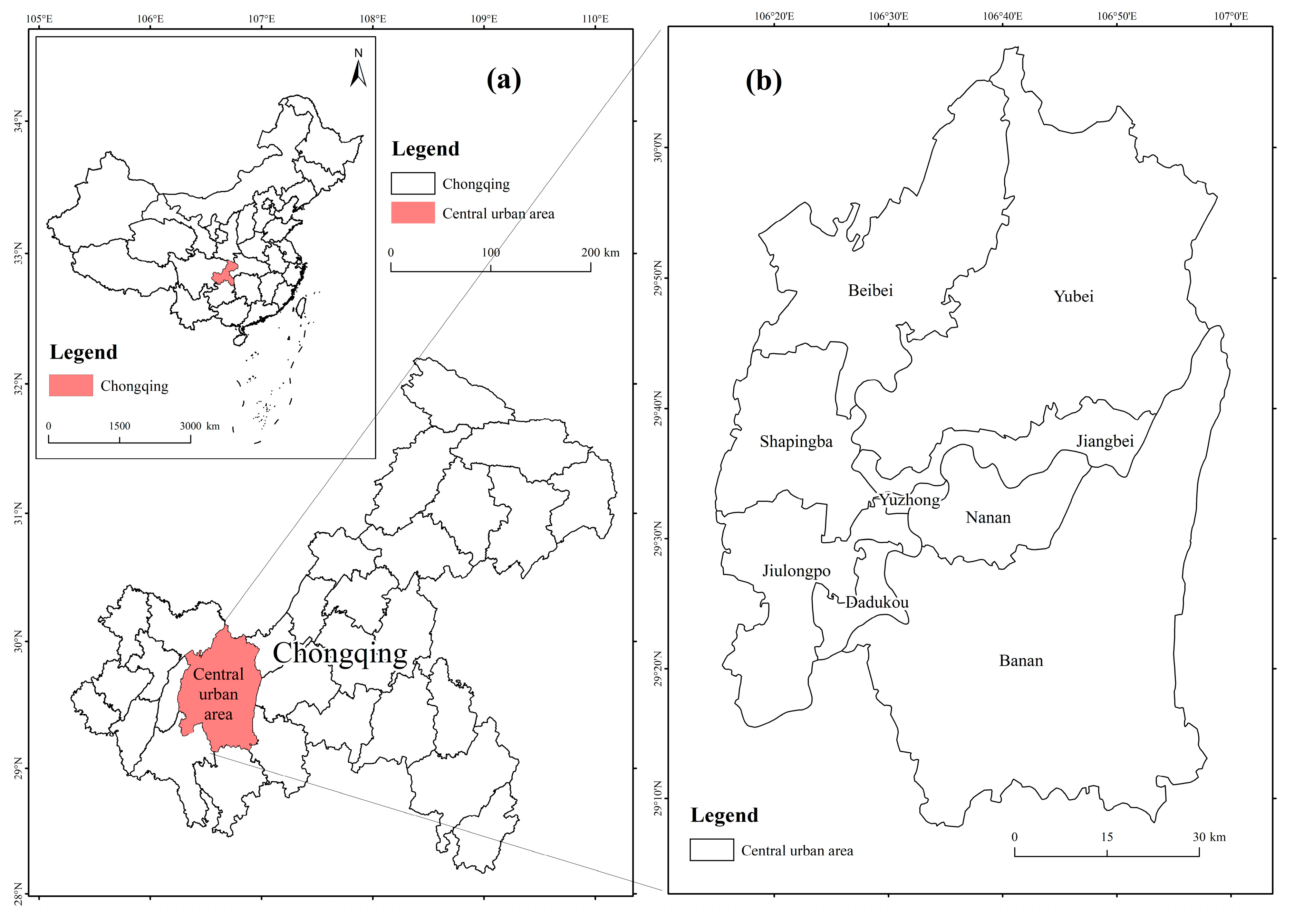
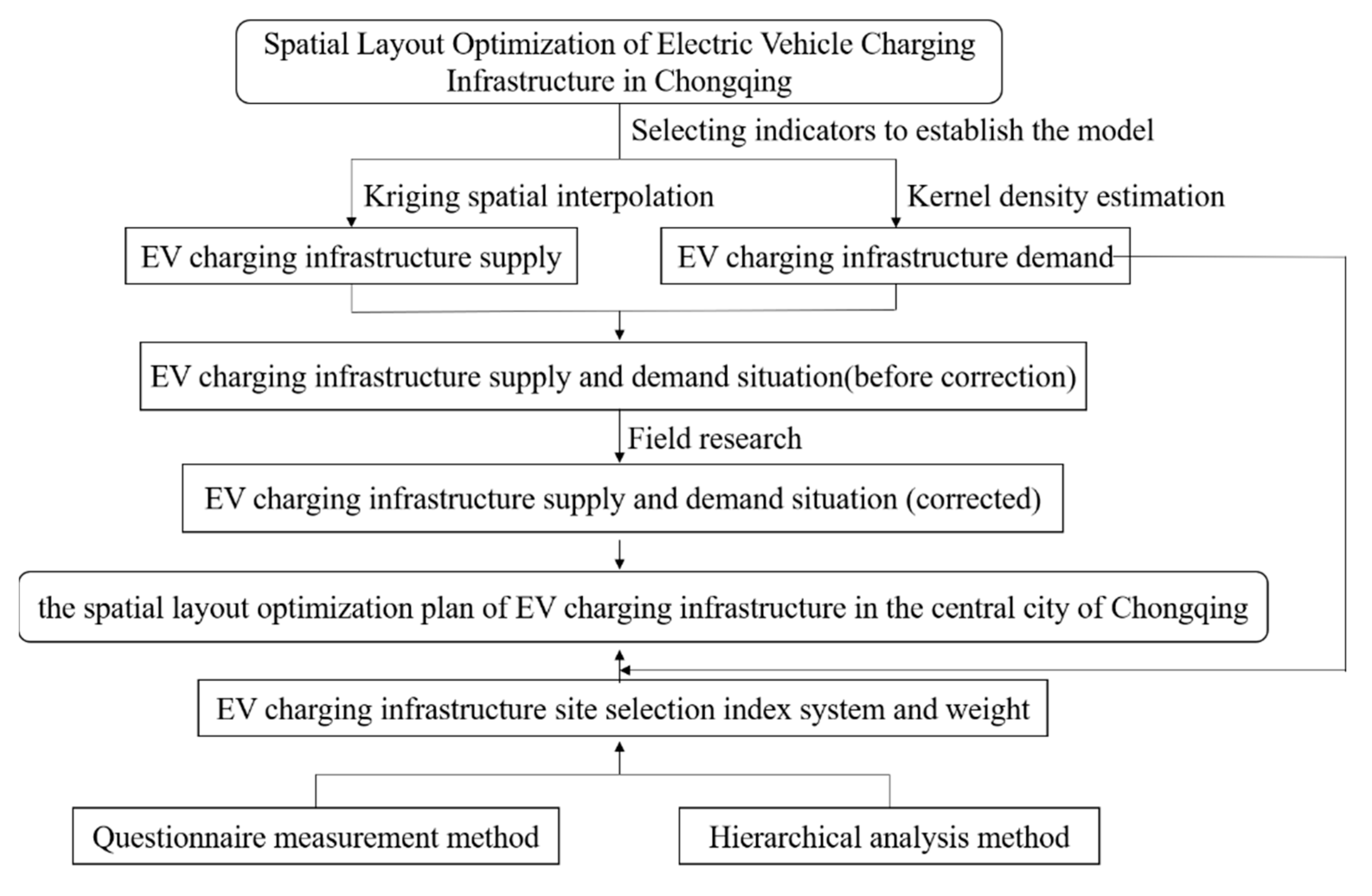
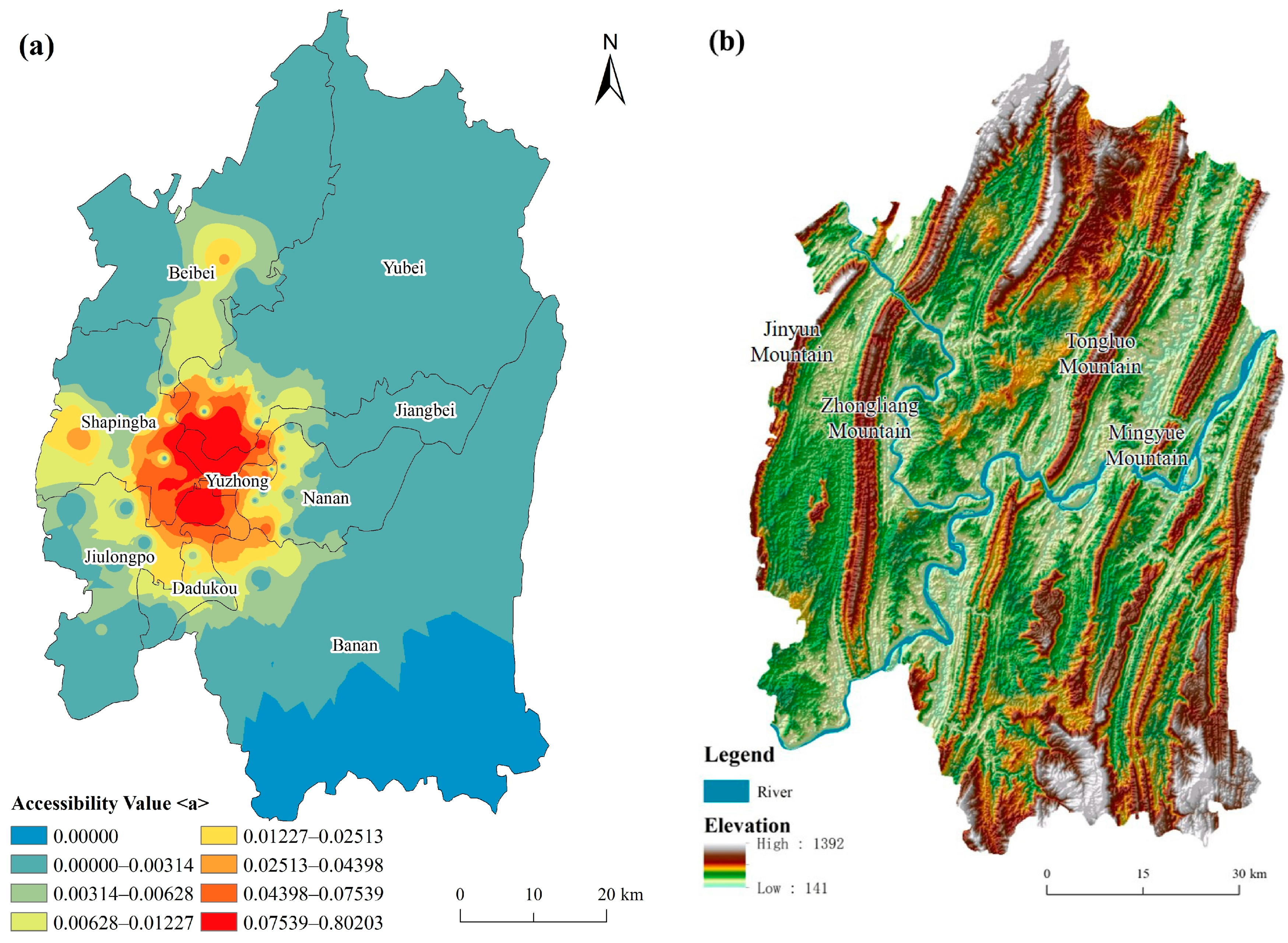
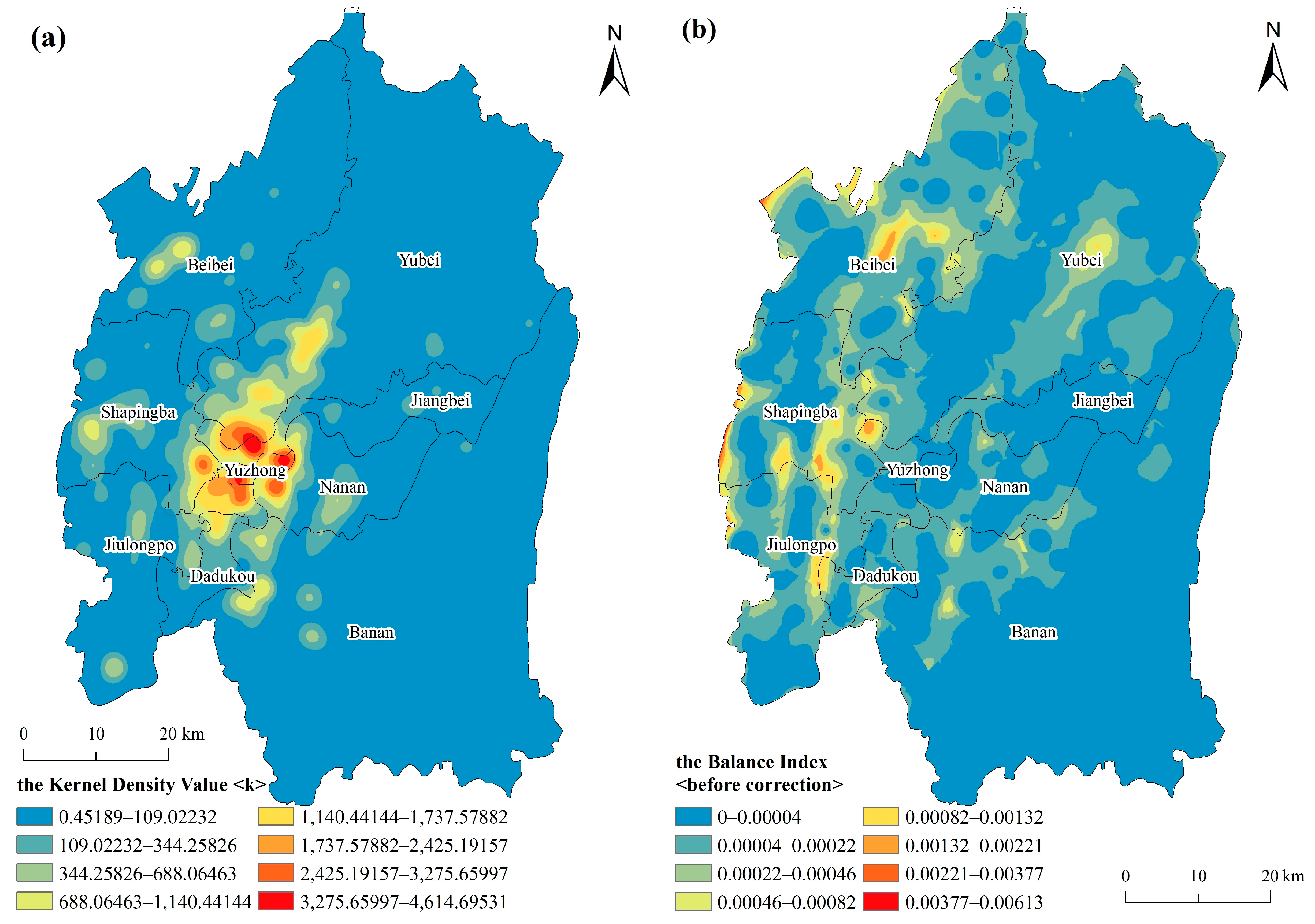
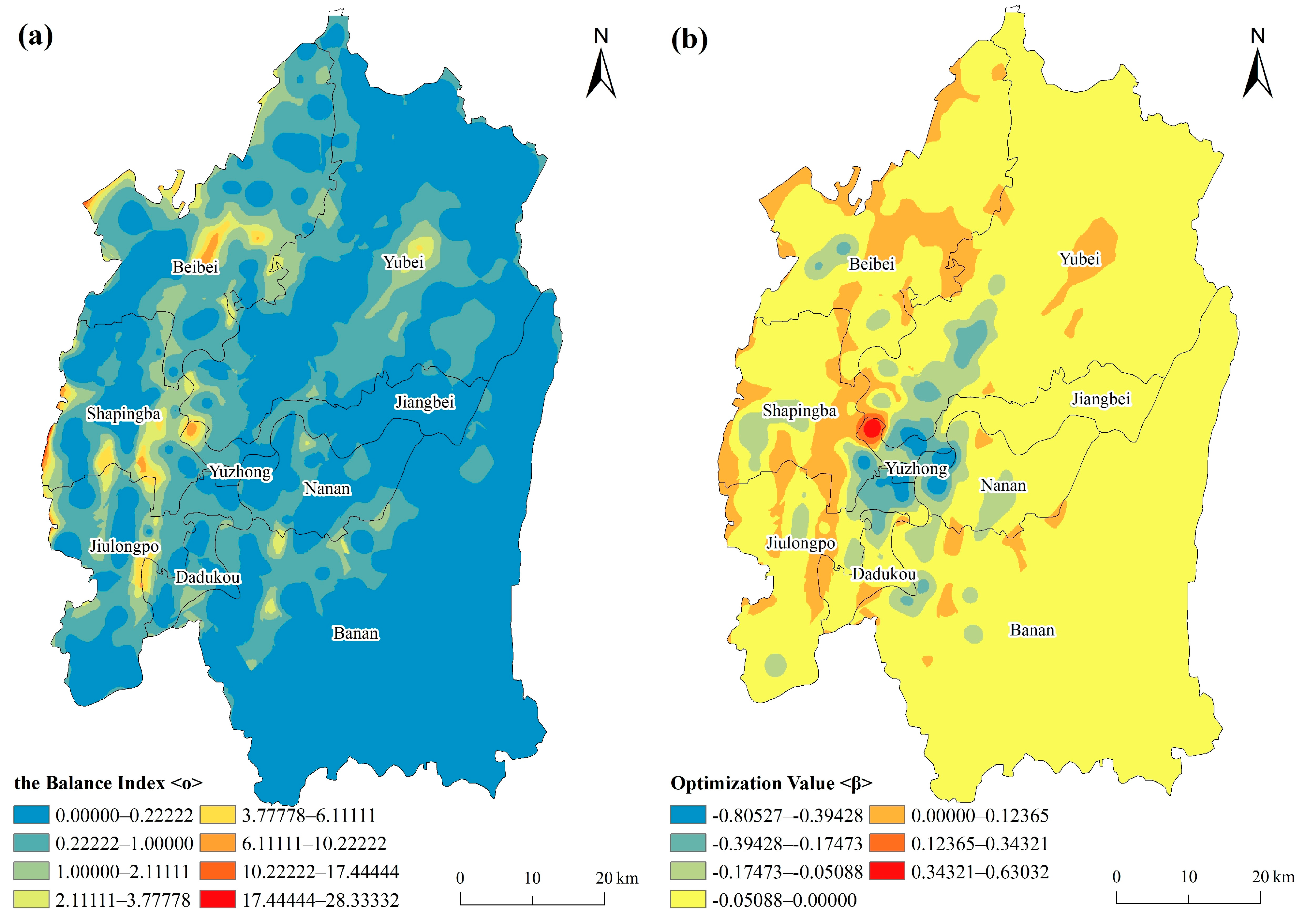
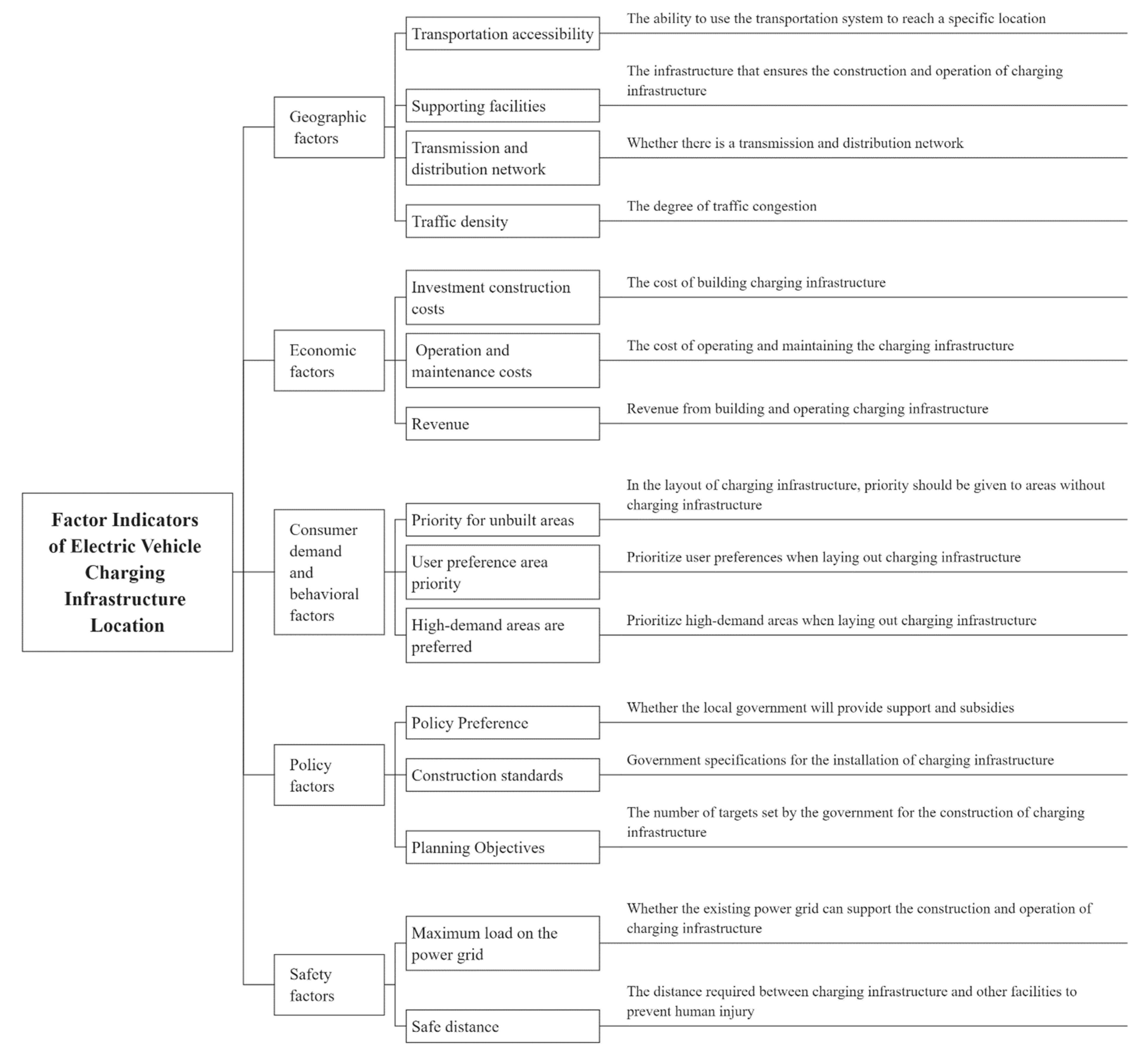
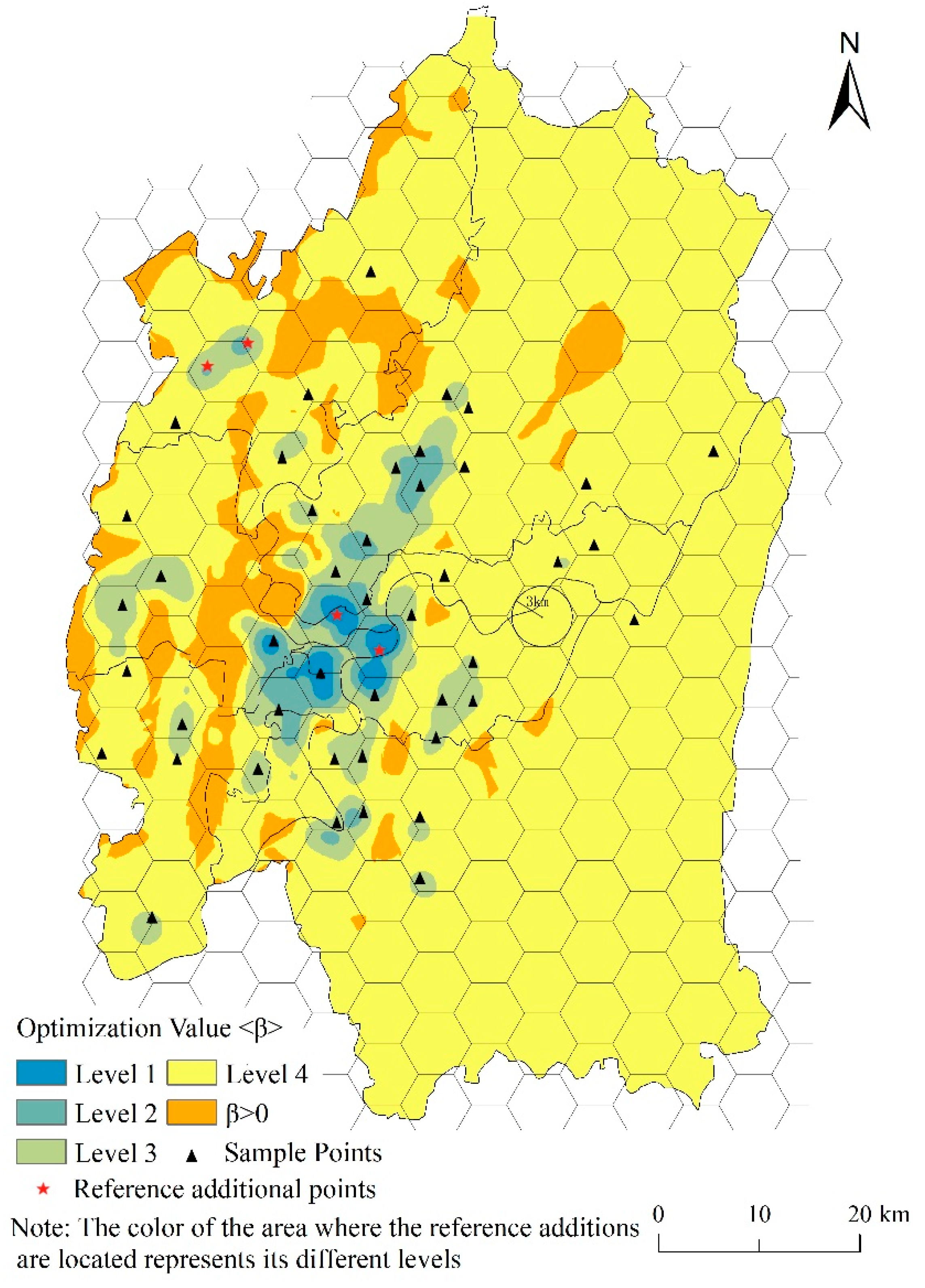
| Region Grade | Evaluation Results |
|---|---|
| Level 1 area | There is no shortage of supply unless there is an exceptional circumstance. |
| Level 2 area | There are occasional shortages of supply except during special peak periods. It is recommended that charging posts be added to such points only when the planning targets are not met, as appropriate. |
| Level 3 area | There is mostly a supply shortage problem during the peak period. It is recommended to use the value of this section as the balance value. |
| Level 4 area | Only one sample exists within the study area, and this sample site is undersupplied only at particular times. |
| Level 5 area | Only one sample exists within the research area, and the charging post is not open to the public. |
| KMO sampling appropriateness measure | 0.879 | |
| Bartlett sphericity test | Approximate chi-square | 1009.770 |
| Degrees of freedom | 190 | |
| Significance | 0.000 | |
| Content | The Saaty Scale | |
|---|---|---|
| 0 | is of equal importance to | 1 |
| (0.18, 0.36] | is slightly more important than , | 3 |
| (0.54, 0.72] | is considerably more important than | 5 |
| (0.90, 1.08] | is more important than | 7 |
| (1.26, ) | is more important than | 9 |
| Indicators | Weight | Combination Weight |
|---|---|---|
| A. Geographic factors | 0.2376 | - |
| A1. Transportation accessibility | 0.2656 | 0.0631 |
| A2. Supporting facilities | 0.4228 | 0.1005 |
| A3.Transmission and distribution network | 0.1744 | 0.0414 |
| A4. Traffic density | 0.1372 | 0.0326 |
| B. Economic factors | 0.0949 | - |
| B1. Investment construction costs | 0.1958 | 0.0186 |
| B2. Operation and maintenance costs | 0.4934 | 0.0468 |
| B3. Revenue | 0.3108 | 0.0295 |
| C. Consumer demand and behavioral factors | 0.3632 | - |
| C1. Priority for unbuilt areas | 0.1958 | 0.0711 |
| C2. User preference area priority | 0.3108 | 0.1129 |
| C3. High-demand areas are preferred | 0.4934 | 0.1792 |
| D. Policy factors | 0.1257 | - |
| D1. Policy Preference | 0.3108 | 0.0391 |
| D2. Construction standards | 0.1958 | 0.0246 |
| D3. Planning Objectives | 0.4934 | 0.0620 |
| E. Safety factors | 0.1795 | - |
| E1. Maximum load on the power grid | 0.6667 | 0.1197 |
| E2. Safe distance | 0.3333 | 0.0598 |
| Sample Information | 01 | 02 | 03 | 04 |
|---|---|---|---|---|
| Coordinates of additional reference points (CGCS2000) | 638,485.524 3,301,976.728 | 634,897.446 3,299,056.463 | 648,089.202 3,274,887.625 | 652,518.551 3,272,672.95 |
| Specific address | Chongbai Shopping Center parking lot, Tiansheng New Village No. 63, Beibei, Chongqing. | Haiyu Hotel parking lot, No. 198 Shuangyuan Avenue, Beibei, Chongqing. | Longhu North Shore Constellation underground parking lot, Beicheng Tianjie No. 4, Guanyin Bridge, Jiangbei Chongqing. | Da Rong City underground parking lot, Yingli No. 26 Minquan Road, Jiefangbei, Yuzhong, Chongqing. |
Disclaimer/Publisher’s Note: The statements, opinions and data contained in all publications are solely those of the individual author(s) and contributor(s) and not of MDPI and/or the editor(s). MDPI and/or the editor(s) disclaim responsibility for any injury to people or property resulting from any ideas, methods, instructions or products referred to in the content. |
© 2023 by the authors. Licensee MDPI, Basel, Switzerland. This article is an open access article distributed under the terms and conditions of the Creative Commons Attribution (CC BY) license (https://creativecommons.org/licenses/by/4.0/).
Share and Cite
Wang, Z.; Yang, Q.; Wang, C.; Wang, L. Spatial Layout Analysis and Evaluation of Electric Vehicle Charging Infrastructure in Chongqing. Land 2023, 12, 868. https://doi.org/10.3390/land12040868
Wang Z, Yang Q, Wang C, Wang L. Spatial Layout Analysis and Evaluation of Electric Vehicle Charging Infrastructure in Chongqing. Land. 2023; 12(4):868. https://doi.org/10.3390/land12040868
Chicago/Turabian StyleWang, Zixuan, Qingyuan Yang, Chuwen Wang, and Lanxi Wang. 2023. "Spatial Layout Analysis and Evaluation of Electric Vehicle Charging Infrastructure in Chongqing" Land 12, no. 4: 868. https://doi.org/10.3390/land12040868
APA StyleWang, Z., Yang, Q., Wang, C., & Wang, L. (2023). Spatial Layout Analysis and Evaluation of Electric Vehicle Charging Infrastructure in Chongqing. Land, 12(4), 868. https://doi.org/10.3390/land12040868






